Whether you have a manicured garden or a cottage-style garden, adding beautiful flowering plants with sweet fragrances will enhance its beauty.
Fragrant flowers can add another layer of richness in any landscape.
Fragrant Viola Odorata | kassandra2 – DepositPhotosEven if you have a small garden, fragrant perennials are a great addition to make it more luxurious.
Take ginger lilies, for instance, the butterfly-shaped petals and the sweet fragrance of its flowers make any garden lively and vibrant.
Some fragrant perennials have a soft scent, which must be placed closer to your house to fully appreciate.
In contrast, others can engulf the whole garden with their beautiful fragrance.
No matter how strong or subtle the scent is, the flowering plants increase the beauty and enjoyment of a landscape.
Let’s have a look at some of the beautiful perennials you may add in your garden for fragrance and beauty.
Pinks (Dianthus Spp.)
Dianthus plants are a genus in the Caryophyllaceae family and are native to Asia and Europe.
These plants have more than 300 flowering plant species.
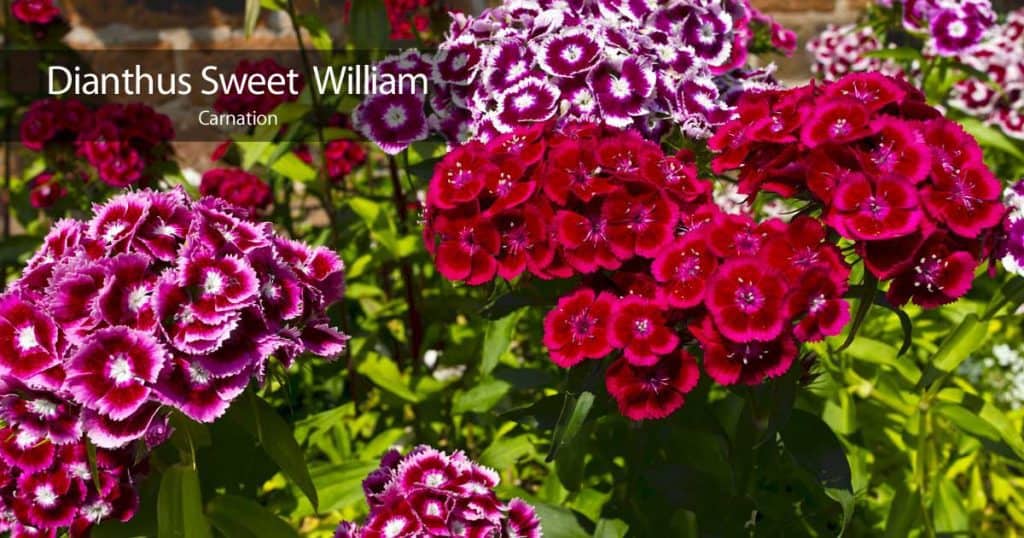 Dianthus flowers have a fragrance with clove or cinnamon tones.
Dianthus flowers have a fragrance with clove or cinnamon tones.
These hardy perennials typically grow 6″ to 18″ inches tall with slender foliage and thick stems.
The flower colors range between white, red, salmon, and pink hues.
They need water when the soil is dry and must be fed after six to eight weeks.
It is recommended to combine slow-release fertilizer in the potting mix when you are planting this plant.
Sweet Violet (Viola Odorata)
The perennial Viola Odorata plant is often selected for its exquisite fragrance.
It is native to Asia and Europe and belongs in the Violaceae family.
 This hardy plant grows between 2″ to 8″ inches high depending on the conditions it is growing in.
This hardy plant grows between 2″ to 8″ inches high depending on the conditions it is growing in.
Typically, the flowers start blooming in early spring.
If growing in hardiness zone 7 and more, the plant produces blooms in the winter season.
It is best to water this plant frequently to force a bloom.
When growing outdoors, it doesn’t require too much watering.
If you want to extend its blooming period, mix slow-release fertilizer when you plant and add a liquid fertilizer when the flowers start to bloom.
Garden Heliotrope (Valeriana Officinalis)
The herbaceous perennial Heliotrope is native to western Asia and contains more than 230 species.
It is recommended to grow this plant in hardiness zones 5 to 9.
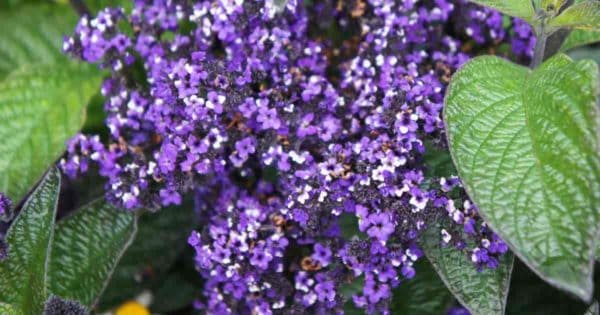 This plant grows about 5″ inches tall and requires sufficient space to grow to its maximum potential.
This plant grows about 5″ inches tall and requires sufficient space to grow to its maximum potential.
The flowers during the summer season and emit a sweet fragrance, which lingers for a few weeks.
The roots of this plant are used as herbal medicine since it has sedative and has anxiolytic properties.
These plants may become invasive when they grow in ideal conditions.
It is best to deadhead the flowers to prevent them from self-seeding.
Fragrant Hosta (Hosta x ‘Royal Standard’)
Hostas are shade-loving perennials with around 70 species and are native to Japan and China.
The plants have large leaves and produce white flowers during the summer season.
These flowers grow on stems, which are 30″ to 40″ inches tall.
These also make excellent cut flowers.
These plants prefer to grow in moist locations and even tolerate the city environment.
These are rather versatile plants with their broad leaves, tall flowers, and subtle colors.
Surprise Lily (Lycoris Squamigera)
The Surprise lily belongs in the family of Amaryllis and is the hardiest plant among the rest of the lilies.
The foliage vibrantly grows during the spring season.
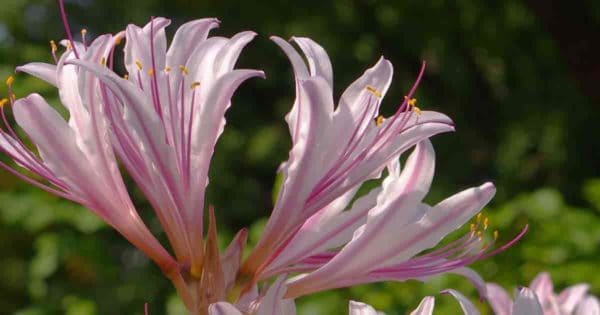 Once the foliage starts to die down, funnel-shaped, fragrant flowers emerge on the stems during late summer or early fall.
Once the foliage starts to die down, funnel-shaped, fragrant flowers emerge on the stems during late summer or early fall.
Make sure to bury the bulbs 8″ to 12″ inches deep in the soil when planting and leave about 6″ inches of space between the plants.
These plants grow best when grown in full sun and well-drained soils.
It requires moderate watering in its growing period.
Don’t transplant as it doesn’t like being disturbed.
Lemon Lily (Hemerocallis Lilioasphodelus)
Native to northern China and eastern Siberia, this herbaceous Daylily perennial grows around 30″ inches tall and 3′ feet wide.
These plants, along with other lilies, have been utilized for medicine, ornaments, and food for more than 2,500 years in their China and Siberia.
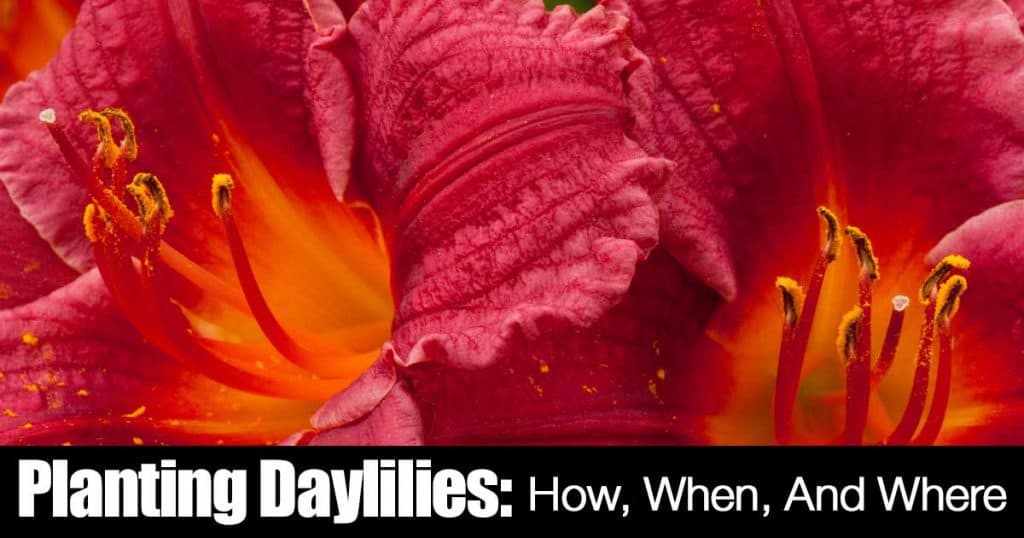 These plants are early bloomers and produce lemon-yellow blooms on arching foliage.
These plants are early bloomers and produce lemon-yellow blooms on arching foliage.
The flowers have a citrus fragrance. It gradually spreads, forming colonies.
The flowers provide an excellent contrast to its dark and graceful foliage.
When you use this plant as a bedding plant or planting in masses, make sure to space the plants about 30″ inches apart.
Under ideal growing conditions, this plant can live for nearly a decade.
It thrives in full sun and grows well in partial shade.
It easily adapts to both moist and dry environments.
Madonna Lily (Lilium Candidum)
The Madonna Lily is among the oldest known garden flowers and is native to the Middle East and the Balkans.
It produces basal rosettes during the winter season with shallow bulbs.
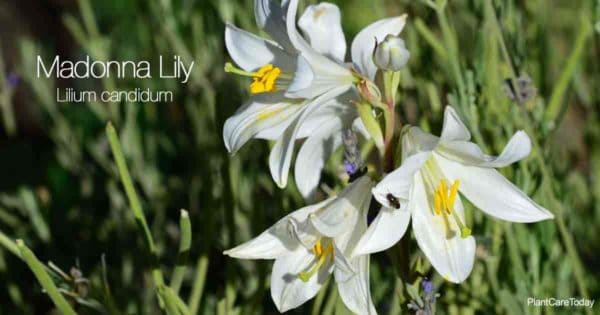 The flowers bloom in the late spring on top of leafy stems.
The flowers bloom in the late spring on top of leafy stems.
The flowers are trumpet-shaped, and white with yellow tint around their throats.
These plants are known for the candy-like delicious and intense fragrance of their blooms.
It is best to plant them under the full sun but with protection from the harsh heat of the afternoon sun.
Narcissus (Narcissus spp.)
This plant is one of the most popular flowering plants around the world.
Narcissus is a genus of perennial plants, which comprise of flowers like paperwhites, jonquils, and daffodils.
It belongs to the family of Amaryllis.
The scented flowers emerge between late winter and spring season.
After the blooming period, the flowers must be deadheaded to stop seed formation.
However, the foliage doesn’t need cutting back until it starts yellowing.
Tropical Water Lilies (Nymphaea Spp.)
Tropical water lilies belong to the family of Nymphaeaceae and are native to the tropical regions of the world.
These plants don’t like the winter season and die off in the cold weather.
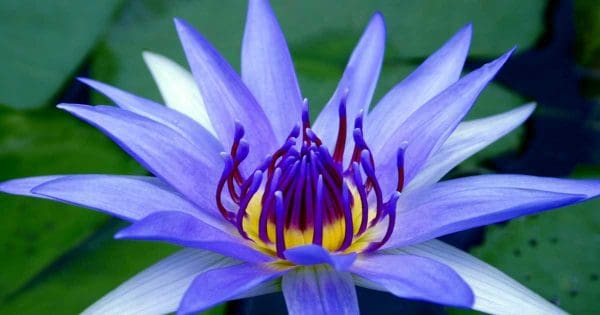 They have to be replaced in the next pond season.
They have to be replaced in the next pond season.
These plants produce shiny, round leaves with crinkled edges.
The plant grows fragrant flowers on its long stems.
The flowers are about 13″ inches wide and float above the water surface.
The fragrance is usually citrus or floral, depending on the variety.
These plants produce crowns and must be grown in deeper pots.
Place the crown on the soil surface and cover with a potting mixture and an inch of gravel.
Lotus (Nelumbo Lutea, N. Nucifera)
Nelumbo is a genus of plants containing merely two species – Nelumbo Lutea and Nelumbo Nucifera.
These aquatic plants belong to the family of Nelumbonaceae.
These plants are native to Australia, Asia, and North America, mostly found growing in the mud of waterlogged fields, ponds, swamps, lakes, lagoons.
The roots of this plant form in the mud firmly, and the leaves are formed on the long stems.
The disc-shaped leaves are sometimes raised above the surface of the water.
The beautiful flowers always float above the water.
The flowers are fragrant, but the intensity usually differs as per the species.
Typically, the fragrance is described as sweet, fruity, and pleasant.
Red Valerian (Centranthus Ruber)
The Centranthus Ruber perennial is also grown as a biennial plant and is grown for its showy and ornamental star-shaped flowers.
This plant has the longest blooming period.
It produces grayish-green leaves and clusters of small fragrant flowers during the late spring season.
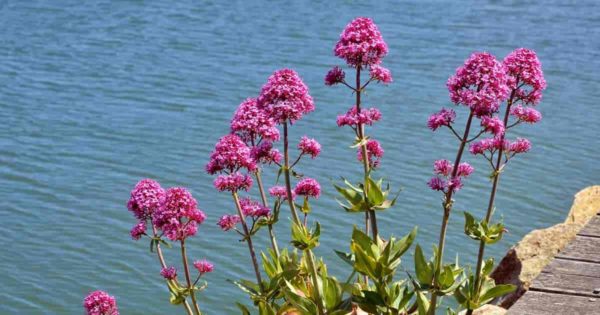 The flowers have a rather intense and robust fragrance.
The flowers have a rather intense and robust fragrance.
It is recommended to deadhead the fading flowers to encourage more blooms.
It is an excellent plant for dry, hot sites and grows well even in paving stones and rock walls.
Fragrant Solomon’s Seal (Polygonatum odoratum var. Variegatum)
The graceful Solomon Seal perennial is native to woodland areas and shaded slopes of North America and Asia.
These plants belong to the Asparagaceae family.
It produces arching 2′ to 3′ feet tall stems, narrow leaves, and pure white flowers.
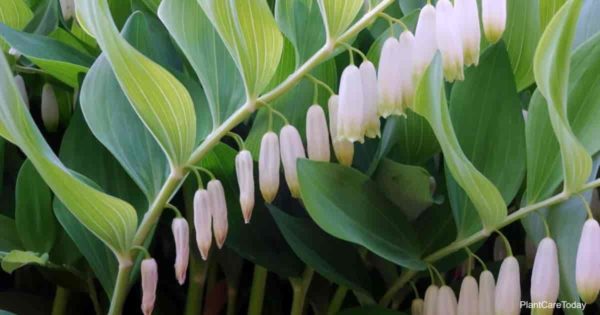 The blooming period of this plant is between late spring and early summer.
The blooming period of this plant is between late spring and early summer.
The flowers emit a sweet fragrance.
These beautiful, dangling white blossoms mature into black fruits during the fall season when the foliage starts yellowing.
The foliage, arching stems, and charming flowers make this plant a favorite for woodland landscapes and shade gardens.
Ginger Lily (Hedychium coronarium)
The flowering Hedychium coronarium is native to tropical Asia and India and belongs to the Zingiberaceae family.
The stalks are produced from slow-growing rhizomes, growing about 5′ feet tall.
The plant blooms during the late summer season when it produces white flowers resembling the shape of a pinecone.
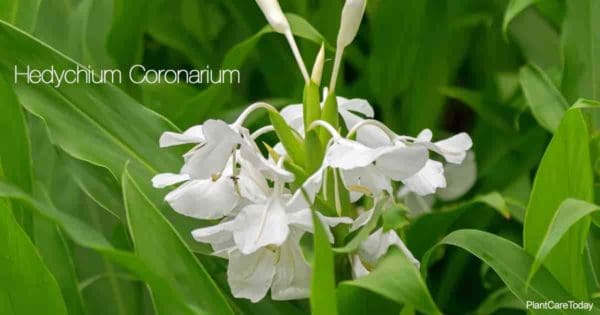 As the flower grows, it fully opens wide about 2″ inches.
As the flower grows, it fully opens wide about 2″ inches.
The shape of the fully opened flower looks like butterfly wings, which is why it is also known as butterfly ginger.
These flowers release a honey-like sweet fragrance through its blooming period.
Acidanthera (Acidanthera Bicolor)
These flowering plants belong in the Iridaceae family and are native to Africa.
Acidanthera is closely related to gladiolus.
These plants produce star-shaped, delicate flowers.
 The white flowers have a sweet yet strong fragrance.
The white flowers have a sweet yet strong fragrance.
These look excellent when growing along borders.
They grow best in hardiness zones 7 to 11.
It is best to place these plants in a sunny spot where it will grace your garden with its exotic-looking blooms.
Regal Lily (Lilium Regale)
The Regal Lily is considered the ultimate lily to grow in any garden.
These are native to Sichuan Province in China and cultivated as ornamental plants in other areas.
This plant produces arching or erect stems with shiny, scattered leaves.
The stems bear trumpet-shaped and intensely fragrant flowers.
The blooms are purple with gold anthers and yellow centers.
It is best to grow this plant in full sun and well-drained, moist soil.
Deadhead the faded flowers to encourage more blooms and cut back the leaves and stems when they start turning yellow.
Ideally, transplant this plant during fall and spring seasons.
Lily-of-the-Valley (Convallaria Majalis)
The Lily-of-the-Valley is one of the most favorite flowering plants around the world grown for its enchanting fragrance.
This plant is native to Europe and Asia where it produces white, bell-shaped flowers during the spring season.
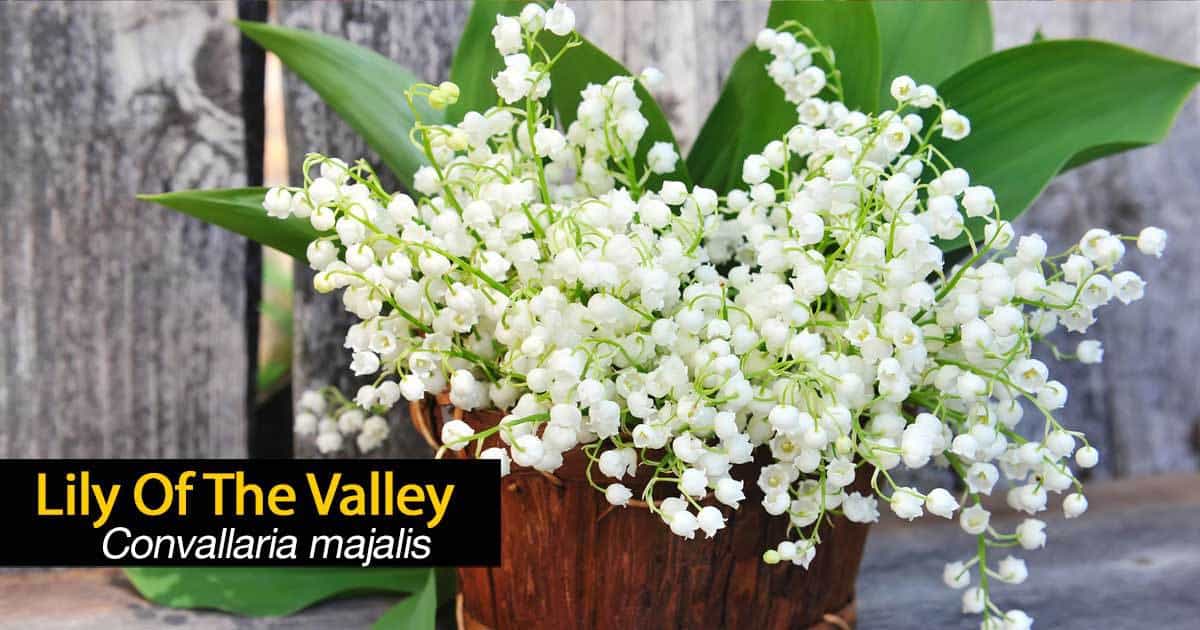 In some areas, this plant is considered a weed due to its ability to spread rapidly.
In some areas, this plant is considered a weed due to its ability to spread rapidly.
Numerous cultivars are grown, including ones with variegated foliage, rose-colored blooms, and double flowers.
It is essential to note, the Lily of the Valley plant is highly poisonous and should never be ingested.
The poison is typically located in seeds, stems, leaves, and roots.
It is essential to handle this plant with caution.
Dutch Hyacinth (Hyacinthus Orientalis)
The spring-flowering Hyacinthus Orientalis is a hardy plant from the Lily family and native to Eastern Mediterranean areas.
These plants produce strap-shaped, narrow leaves, and prefer to grow in full sun.
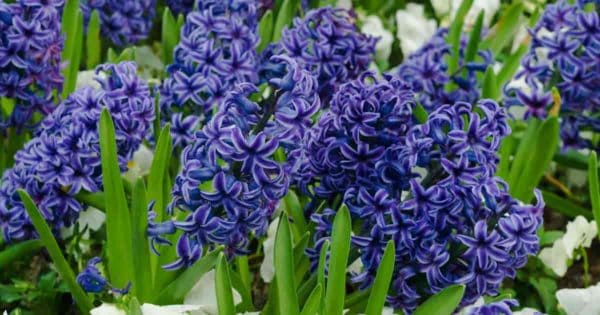 The plant grows about 6″ to 12″ inches tall with erect stalks.
The plant grows about 6″ to 12″ inches tall with erect stalks.
During the spring season, it produces funnel-shaped fragrant flowers.
The flower colors include purple, blue, lavender, red, pink, yellow, and white.
These blooms have the loveliest fragrance.
You are bound to notice the bright colors and intense scent of these flowers, even from a distance.
It is summer drought-tolerant but requires moisture after being planted and throughout its growing season.
These work best in rock gardens, borders, and beds.
Lavender (Lavandula Angustifolia)
The Lavender plant belongs in the Asparagaceae family and is often considered as an herb.
However, it is a perennial flowering plant with woody stems and fragrant flowers.
 These are drought-tolerant, forgiving, and versatile plants.
These are drought-tolerant, forgiving, and versatile plants.
The purple flowers have a strong, delightful fragrance.
The flowers and leaves are often used for potpourris and sachets, but also make an attractive plant in any garden.
Tuberose (Polianthes Tuberosa)
The perennial Tuberose plant belongs in the Asparagaceae family and is native to Mexico.
It is widely used as an ornamental plant, and its extract is used in perfumery.
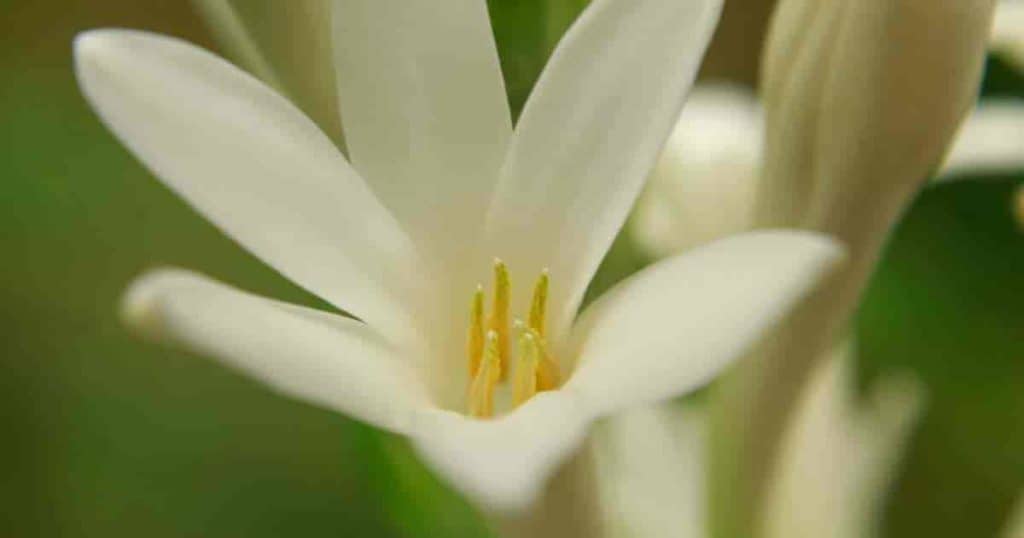 The stalks of this plant are about 4′ feet tall and produce clusters of white, showy flowers during the late summer season.
The stalks of this plant are about 4′ feet tall and produce clusters of white, showy flowers during the late summer season.
The flowers have an enticing and robust fragrance.
It is best to keep it potting mix moist before and throughout the blooming period of this plant.
Poor soil should be improved with organic and compost amendments to result in the best flowers.
Recommended Reading
- 21 Favorite Fragrant Garden Flowers
- Fragrant Annuals














